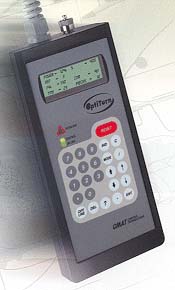Add-On Adaptive Control is now a Reality
By Ariel Nosrat
Of the many CNC machine tool technology innovations that occurred in the past century, two are considered functionally revolutionary: digitized motion control achieved through CNC technology and digitized geometry and motion definition (CAD/CAM).
While CNC technology coupled with CAD/CAM systems (introducing flexibility in batch production) provides an agile alternative to more conventional rigid manufacturing technologies, some major inefficiencies remain. Present day CNC technology relies on the manual input of appropriate cutting parameters even when sophisticated CAD/CAM systems are used to generate NC programs. NC programming —whether based on CAD/CAM or otherwise—is virtually carried out in a vacuum.

Limiting CNC factors
The control mechanisms of present day CNC machines are limited to geometry and kinematics. As such, they follow pre-programmed constant speed and feedrates during each cutting operation. Consequently, they do not have the flexibility to adapt to the dynamic changes that occur during cutting. This inflexibility would be acceptable if cutting conditions were uniform during machining. However, cutting conditions continuously vary for the following reasons:
- Workpiece surface is often not even, whether the raw material is a bar stock, forging or casting.
- Tool sharpness declines during machining due to tool wear.
- Workpiece material is generally not homogeneous and material hardness varies within each workpiece.
- Material hardness and workpiece dimensions vary from piece to piece and even more so from batch to batch.
- Cooling qualities vary during machining resulting in temperature variations.
- Fixture's stability may be affected by dynamically varying forces.
- NC programs may contain errors.
The CNC conundrum
Advances in CAD/CAM technology have caused machine shops to focus most of their attention to "defining the required geometry" while ignoring the other above mentioned aspects. However, with all of the different variations, NC programmers must be extremely conservative when determining cutting parameters, resulting in safer but inefficient cutting processes. Consequently, in an attempt to shorten cycle times, NC programmers have to set aggressive cutting parameters, often resulting in catastrophic damage to tools, parts and machine.
No matter how optimized NC programs may be, they cannot account for the dynamic variations that occur during cutting and are unable to adapt to continuously varying cutting conditions. At best, very long NC programs may be created with different feedrates for each segment. But even this action fails to adapt cutting parameters in real-time to real-life cutting conditions.
Dynamic optimization solution
The dilemma of conservative programming vs. the need for speed is solved through the implementation of "adaptive control." Effective adaptive control fully optimizes the cutting process, in real time, based on continuously monitored cutting conditions. Adaptive control is the CNC technology of tomorrow—available today.
Such systems are indispensable if expensive CNC machines are ever to run at their full capacity and if cutting tools are to be utilized to their maximum life, rather than incurring in-process catastrophic breakage and production disruption. In addition, machine operators are not required to intervene in the machining process to watch and manually tune. In this way, true automation is a reality.
Drastic cost reductions, dictated by an increasingly competitive market, require manufacturers to cut all elements of machining costs. These include machining cycle times, machine operating costs, tooling costs, NC programming costs and the cost of long lead-times. Real time in-process optimization technology—as implemented in adaptive control systems—addresses all of these economic issues.
Adaptive controls on the shopfloor
Since most machine shops will keep their current CNC machines, optimization features must be installed on existing machinery to reach maximum production levels. To this end, real-time dynamic optimization systems have to be integrated as "add-on" peripheral devices, installed on any CNC machine. Today, innovative optimization technologies, such add-on systems designed by OMAT Control Technologies, are available and in worldwide use on many existing CNC machines.
OMAT's add-on real-time optimization systems, OptiMil (for milling and drilling applications) and OptiTurn (for turning applications), connect directly to CNC machines, sense and monitor actual cutting conditions, and adjust feedrates to optimal levels in real time. This ensures a constant cutting load, which takes into account the variations in the cutting conditions during the cut. In this way, these systems ensure that machine cycle times are minimized and machines run at the maximum permissible capacity for each tool.
One of the systems' most attractive features is that they apply the optimal feedrate, in real time, based on the most basic parameters for each specific tool and material. These parameters may be input, if necessary, from an external tool library. The operator is not required to know specific load threshold for each tool, as the internal expert system determines these limits automatically.
With OptiMil and OptiTurn, NC programmers can be aggressive and program feeds as though tools were new and sharp. During cutting, the add-on systems automatically compensate for tool wear, since feedrates are continuously adjusted as a function of the extent of tool wear. The systems also give operators a quantitative indication of tool wear during the cut. Operators no longer have to run the machine until the tool gives out. Based on the systems' indication, operators can replace the worn tools in time, without incurring costly and disruptive tool breakage or replacing the tool sooner than necessary.
In addition to detecting tool wear, OptiMil and OptiTurn also protect tools from breakage through their sensitivity to the spindle load. Fewer broken tools also reduces scrap and the need for rework. Breakage protection is provided through an alarm system that alerts the machine operator/supervisor when acute overload conditions occur and, if necessary, automatically stops the machine.
OMAT's real-time control systems ensure automatic optimization of the machining process to reduce cycle times, increase tool utilization and prevent tool breakage, thus enhancing the machine capacity. In this way, users have typically increased productivity by as much as 20-30%.
OMAT Control Technologies, 5 Nahum Hafzadi, PO BOX 34272,
Jerusalem, 91341, Israel; phone: 972 2 651 0310
